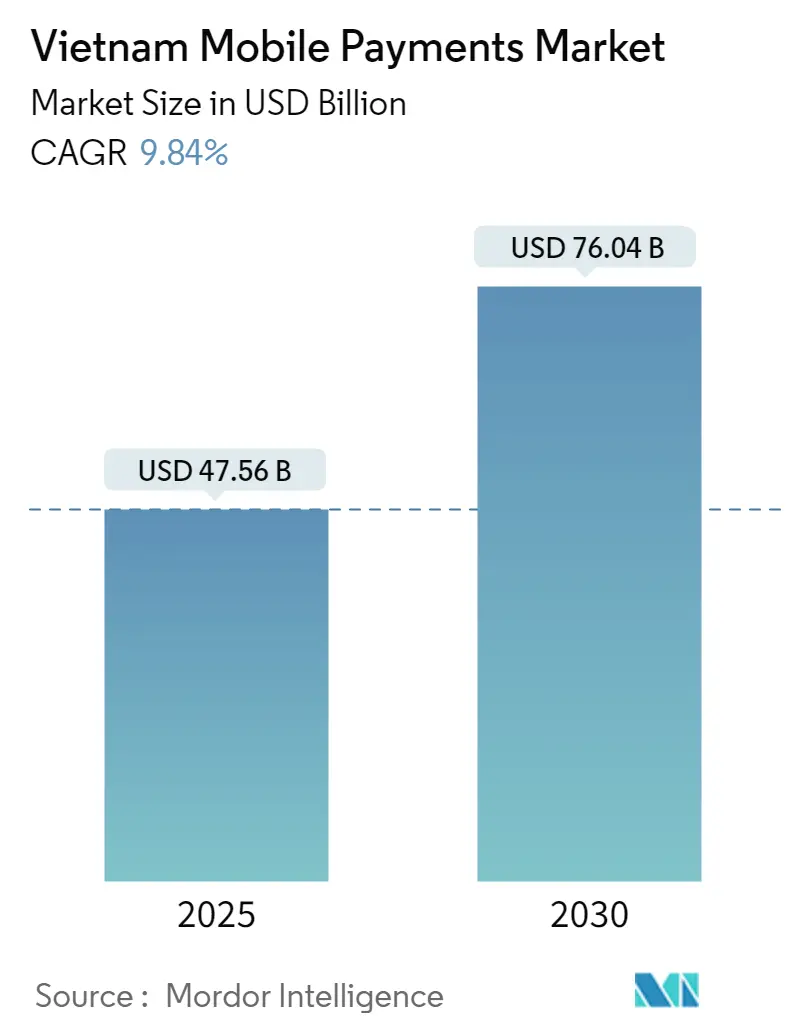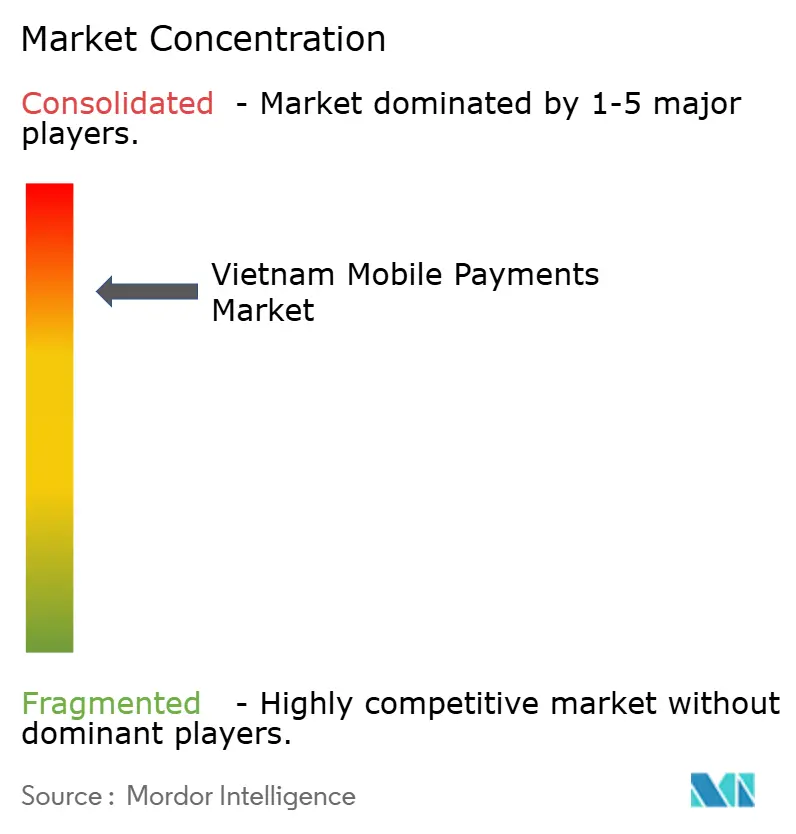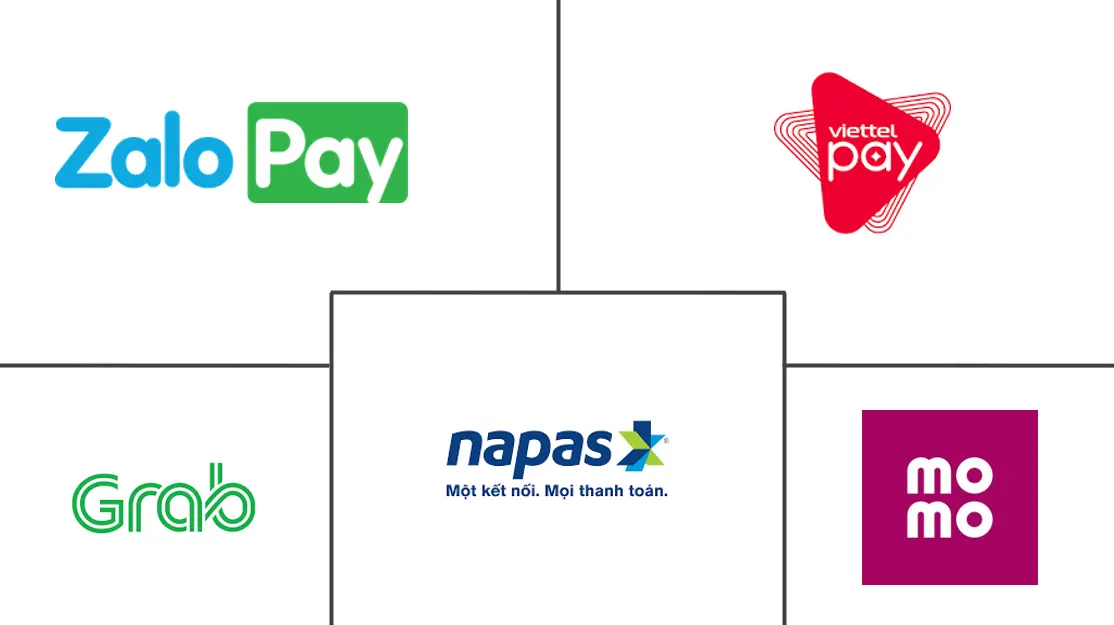
Vietnam Mobile Payments Market Analysis by Mordor Intelligence
Vietnam mobile payments market size stands at USD 47.56 billion in 2025 and is forecast to reach USD 76.04 billion by 2030, registering a 9.84% CAGR. Widespread smartphone ownership, 5G rollouts, and a policy mandate for 80% cashless public-service transactions create sustained demand for real-time digital payments [sbv.gov.vn]. Remote payment dominance, cross-border QR interoperability with Thailand, Singapore, Cambodia, and Laos, and aggressive super-app expansion collectively reinforce Vietnam’s position as Southeast Asia’s payment integration hub. Extension of the Mobile Money pilot program, the July 2025 legal recognition of e-wallets, and an 86.97% bank-account penetration rate reduce structural adoption barriers. Intensifying proximity transaction growth, led by Apple Pay’s arrival and 75% contactless penetration on Visa rails, signals a shift from remote-only habits toward omnichannel payment behaviour. Meanwhile, biometric authentication cuts fraud by up to 57%, supporting consumer trust and widening the use-case spectrum across retail, transport, utilities, and government services.
Key Report Takeaways
- By payment type, remote payments led with 69.36% Vietnam mobile payments market share in 2024; proximity payments are projected to advance at a 13.85% CAGR through 2030.
- By payment mode, QR code transactions accounted for 55.41% of the Vietnam mobile payments market size in 2024, while NFC tap-to-pay is poised for the fastest 13.22% CAGR to 2030.
- By end-user, retail and consumer goods captured 61.77% of the Vietnam mobile payments market size in 2024; utilities and public services exhibit the highest projected 12.43% CAGR through 2030.
- By transaction type, person-to-person transfers represented 64.82% Vietnam mobile payments market share in 2024, while person-to-business flows are forecast to expand at a 14.12% CAGR to 2030.
Vietnam Mobile Payments Market Trends and Insights
Drivers Impact Analysis
| Driver | (~) % Impact on CAGR Forecast | Geographic Relevance | Impact Timeline |
|---|---|---|---|
| Rising internet and smartphone penetration | +2.10% | National, with rural acceleration | Medium term (2-4 years) |
| Government push for cashless economy | +1.80% | National, with policy spillover to ASEAN | Long term (≥ 4 years) |
| Surge in e-commerce spend | +1.60% | Urban centers, expanding to Tier-2 cities | Short term (≤ 2 years) |
| Super-app ecosystem partnerships | +1.40% | National, with cross-border potential | Medium term (2-4 years) |
| Rapid QR-code merchant onboarding via VNPay24 | +1.20% | National, with SME focus | Short term (≤ 2 years) |
| Cross-border QR linkage with Thailand and Singapore | +0.90% | Border provinces, tourist corridors | Long term (≥ 4 years) |
| Source: Mordor Intelligence | |||
Government Push for Cashless Economy
Vietnam’s National Digital Transformation Program requires 80% cashless settlement for all public-service fees by 2030, obliging ministries and provincial agencies to integrate mobile payment rails. Mandatory VNeID linkage with major e-wallets simplifies tax, licensing, and welfare disbursement payments. ZaloPay’s education-fee solution illustrates regulatory alignment that opens cross-border tuition flows previously constrained by manual wire transfers. The fintech sandbox hosts 15 licensed firms, shortening go-to-market cycles for novel payment models. Policy continuity sets Vietnam mobile payments market on a region-leading modernization path and influences peer ASEAN regulators.
Surge in E-commerce Spend
Online transaction values exceeded USD 18.2 billion in 2024; 73% cleared via mobile wallets integrated into super-apps that bundle shopping, delivery, and payments. ShopeePay’s automated VAT reporting eliminates manual uploads, boosting merchant compliance and loyalty. Buy-now-pay-later (BNPL) via Cake by VPBank increases average ticket sizes among 25-35-year-olds, who form 68% of BNPL users. Cross-platform loyalty earning Grab ride credits redeemable on Zalo storesdrives higher purchase frequency than siloed apps. The momentum sustains remote volumes while funnelling incremental demand into proximity contexts such as pop-up kiosks and live-commerce events.
Super-app Ecosystem Partnerships
Telco-bank linkages such as VPBank-MobiFone embed savings, credit, and insurance into SIM-based user journeys reaching 32 million subscribers. ZaloPay couples 75 million monthly social-media accounts with an e-wallet that now supports VNeID verification, eliminating app-switch friction. Combined data graphs enhance credit scoring, fraud detection, and hyper-personalized offers, lowering acquisition cost per active user. Such ecosystem synergies deepen engagement and reinforce the moat around Vietnam mobile payments market incumbents while inviting further vertical integration across content streaming, gaming, and micro-investments.
Cross-border QR Linkage with Thailand and Singapore
Napas-PromptPay and Napas-PayNow bridges let Vietnamese tourists pay Thai and Singaporean merchants with domestic wallets, avoiding currency fees and cutting settlement time from two days to minutes. Annual outbound travellers 8 million to Thailand and 2.1 million to Singapore now transact seamlessly abroad, while a USD 3.2 billion remittance corridor gains cheaper rails. Q2 2025 expansion to Cambodia and Laos extends reach, positioning Vietnam mobile payments market as a node in an emerging ASEAN payment mesh that will eventually support Indonesia and the Philippines.
Restraints Impact Analysis
| Restraint | (~) % Impact on CAGR Forecast | Geographic Relevance | Impact Timeline |
|---|---|---|---|
| Cyber-fraud and phishing incidents | -1.30% | National, with urban concentration | Short term (≤ 2 years) |
| Low financial-literacy pockets in rural areas | -0.90% | Rural provinces, ethnic minorities | Long term (≥ 4 years) |
| Fragmented QR-code standards pre-VietQR | -0.70% | National, legacy system integration | Medium term (2-4 years) |
| High interchange fees on small-ticket proximity payments | -0.50% | Urban centers, micro-merchant segments | Medium term (2-4 years) |
| Source: Mordor Intelligence | |||
Cyber-fraud and Phishing Incidents
The BianLian trojan compromised 12,000 accounts in early 2025, spiking fraudulent volumes 34% year-over-year in Q1 2025. Subsequent mandates for biometric sign-in and device-level tokenization cut successful fraud attempts by up to 57%, yet compliance costs pressure small wallets running thin margins. Publicized breaches briefly dented trust among users over 45, who make up 23% of potential adopters, causing temporary slowdowns in new registrations. Annual security audits and real-time monitoring, now compulsory under State Bank directives, heighten operational outlays.
Low Financial-literacy Pockets in Rural Areas
Despite 85% smartphone coverage, 27% of rural residents still prefer cash. Government roadshows and school-level training aim to close knowledge gaps, but multi-year behavioural change is required. Agribank’s deployment of 15,000 QR terminals lifted rural wallet adoption to 41% in 2024, yet transaction density remains 60% below city averages. Language localization for ethnic minorities and trust-building campaigns targeting older generations remain pivotal to unlock the next wave of Vietnam mobile payments market growth.
Segment Analysis
By Payment Type - Remote Dominance Drives Digital Commerce
Remote payments accounted for 69.36% Vietnam mobile payments market share in 2024 and continue scaling through one-click checkout on Shopee and Tiki. Vietnam's mobile payments market size for proximity transactions will grow at a 13.85% CAGR to 2030 as NFC infrastructure spreads across 100,000 new terminals in supermarkets, convenience stores, and metro turnstiles. Contactless Visa transactions already reach 75%, indicating readiness for face-to-face adoption. Remote volume growth now funnels into rural e-commerce, aided by simplified user interfaces and local-language support, while proximity gains urban mindshare in transport and quick-service retail.
Expanding proximity usage is underpinned by Apple Pay’s December 2024 launch through Vietcombank, Techcombank, and VPBank, which accelerated merchant upgrades to NFC readers. Public-transport operators in Ho Chi Minh City observe 70% cashless ridership, cutting boarding times. Remote payment providers broaden into subscription billing and charity donations, keeping penetration high even as proximity narrows the gap.

By Payment Mode - QR Codes Lead Standardization Wave
QR transactions represented 55.41% of Vietnam mobile payments market size in 2024 thanks to VietQR, which unified disparate systems across 2.1 million merchants. The standard halves onboarding time for SMEs and ensures user familiarity with single flow scanning. NFC tap-to-pay, with a 13.22% projected CAGR, attracts premium-phone users accustomed to in-store convenience. USSD-based transfers sustain relevance in low-data environments, holding 8.7% share, particularly among basic-phone owners in mountainous provinces.
Mobile wallet transfers, at 22.1% share, capitalize on P2P culture and contain loyalty ecosystems that lock users in via cash-back and coupon rewards. July 2025 recognition of all payment modes under Circular 40/2024 removes legacy institutional skepticism, leading to wider acceptance among utilities and public sector agencies that previously limited themselves to bank transfers.
By End-User - Retail Transformation Accelerates Adoption
Retail and consumer goods commanded 61.77% Vietnam mobile payments market size in 2024 as Vinmart, Circle K, and Bach Hoa Xanh standardized QR and NFC acceptance across 2,800 collective outlets. Reduced cash reconciliation and lower shrinkage motivate merchants to promote digital incentives such as receipt-linked coupons. Utilities and public services will outpace others at 12.43% CAGR, propelled by mandatory e-payment portals for taxes, electricity, and traffic fines.
Transport and ticketing now feature 70% mobile penetration on metro systems, with national rail and intercity buses testing QR boarding passes. Hospitality and entertainment recover alongside tourism, emphasizing multi-currency wallet acceptance to serve inbound travellers from Thailand, Singapore, and South Korea.

Note: Segment shares of all individual segments available upon report purchase
By Transaction Type - P2P Dominance Reflects Social Commerce
P2P transfers captured 64.82% Vietnam mobile payments market share in 2024 as group gifting, bill splitting, and informal lending drive high-frequency transfers within social circles. Vietnam mobile payments market size for P2B will expand fastest at 14.12% CAGR as SMEs migrate from COD to wallet settlements supported by VietinBank’s merchant onboarding program.
B2B payments remain nascent at 12.3% but gain momentum from digitized invoicing in manufacturing clusters. Cross-border B2B transactions benefit from QR interoperability that reduces correspondent-bank fees, aiding exporters of seafood and electronics who regularly invoice partners in Thailand and Singapore.
Geography Analysis
Ho Chi Minh City and Hanoi contribute roughly 45% of the national transaction value, reflecting dense merchant networks, higher disposable incomes, and advanced 5G coverage. The Vietnam mobile payments market size in these metros continues to expand as super-apps roll out instant credit and insurance add-ons that boost average revenue per user. Secondary cities like Da Nang, Hai Phong, and Can Tho experience double-digit growth fuelled by e-commerce fulfilment centers and tourism revival.
Mekong Delta provinces leverage agricultural subsidies delivered via mobile wallets, replacing cumbersome cash disbursements. Farmers selling rice and fruit now receive payments within minutes, diminishing theft risk and allowing faster reinvestment in inputs. Northern border provinces capitalize on QR-based settlement for small-scale trade with China, easing customs delays and foreign-exchange conversions.
Rural penetration improves through VNeID digital identity, which lets residents open basic e-money accounts without visiting branches. 5G expansion to 80% of communes by 2026 will unlock high-bandwidth services such as biometric fraud prevention and video-KYC. The State Bank’s Mobile Money pilot run by Viettel, MobiFone, and VNPT targets the 13.03% unbanked population in mountainous regions, offering low-fee transfers capped at VND 10 million per month.
Competitive Landscape
Vietnam mobile payments market is moderately fragmented, with MoMo, ZaloPay, ShopeePay, VNPay24, ViettelPay, and GrabPay vying for scale. No single player exceeds a 25% transaction-value share, keeping pricing pressure high and spurring innovation in ancillary services. MoMo achieved first-time profitability in 2024 after handling 5.5 billion transactions in Q1 2025, validating the super-app monetization model. ZaloPay exploits its parent social network to cross-sell payment services, while VNPay24 dominates QR merchant acquisition across SMEs.
Apple Pay’s partnership with major banks accelerates NFC adoption but targets premium users, leaving mass-market room for domestic wallets. Telco-bank alliances such as VPBank-MobiFone create cross-selling opportunities in data bundles, micro-insurance, and consumer loans. Compliance with the State Bank’s sandbox grants early movers regulatory goodwill and API access for nationwide government payments.
Technology is a key differentiator: AI-driven risk scoring enables sub-second approvals, and biometric authentication slashes chargebacks, prompting laggards to invest or face attrition. Expanding cross-border corridors will determine the next competitive frontier, rewarding networks with established foreign partnerships.
Vietnam Mobile Payments Industry Leaders
-
ZaloPay
-
National Payment Corporation of Vietnam
-
MoMo (M_Service)
-
Viettel Digital Services Corporation
-
Grab
- *Disclaimer: Major Players sorted in no particular order

Recent Industry Developments
- April 2025: NAPAS launched QR connectivity with Cambodia and Laos, extending the four-country payment mesh.
- March 2025: ZaloPay added VNeID verification for in-app government fee payments.
- February 2025: VPBank partnered with MobiFone to integrate banking services for 32 million subscribers.
- January 2025: State Bank of Vietnam prolonged the Mobile Money pilot through 2025.
Vietnam Mobile Payments Market Report Scope
Mobile payment is the transfer or payment method of funds, typically to a merchant, person, or business for bills, goods, and services, using a mobile device to execute and confirm the payment. The payment tool can be a mobile browser, digital (virtual or e-) wallet, or SIM toolkit / mobile menu. The study tracks the transaction type of mobile payment by Proximity and Remote payment. The study tracks key market metrics, underlying growth influencers, and significant industry vendors, supporting Vietnam's mobile payments market estimates and growth rates throughout the anticipated period. The study looks at COVID-19's overall influence on Vietnam's payment ecosystem.
The Vietnam Mobile Payments Market is segmented by type (proximity payment, remote payment). The market sizes and forecasts are in terms of value (USD) for all the above segments.
| Proximity Payment |
| Remote Payment |
| NFC Tap-to-Pay |
| QR Code (VietQR, VNPay) |
| USSD / SMS |
| Mobile Wallet App Balance Transfer |
| Retail and Consumer Goods |
| Transport and Ticketing |
| Utilities and Public Services |
| Hospitality and Entertainment |
| Person-to-Person (P2P) |
| Person-to-Business (P2B) |
| Business-to-Business (B2B) |
| By Payment Type | Proximity Payment |
| Remote Payment | |
| By Payment Mode | NFC Tap-to-Pay |
| QR Code (VietQR, VNPay) | |
| USSD / SMS | |
| Mobile Wallet App Balance Transfer | |
| By End-User | Retail and Consumer Goods |
| Transport and Ticketing | |
| Utilities and Public Services | |
| Hospitality and Entertainment | |
| By Transaction Type | Person-to-Person (P2P) |
| Person-to-Business (P2B) | |
| Business-to-Business (B2B) |
Key Questions Answered in the Report
How large is the Vietnam mobile payments market in 2025?
The Vietnam mobile payments market size is USD 47.56 billion in 2025.
What is the projected CAGR for Vietnam mobile payments through 2030?
The market is forecast to expand at a 9.84% CAGR from 2025 to 2030.
Which payment type dominates transaction volume?
Remote payments lead, holding 69.36% market share in 2024.
Why are QR codes so popular in Vietnam?
VietQR standardization unified merchant acceptance and pushed QR transactions to 55.41% of all payments in 2024.
What role do super-apps play in adoption?
Super-apps bundle payments with shopping, rides, and services, lowering customer acquisition costs and driving higher engagement.
How is fraud being mitigated in mobile payments?
Mandatory biometric authentication and AI risk scoring have reduced successful fraud attempts by up to 57%.
Page last updated on:



